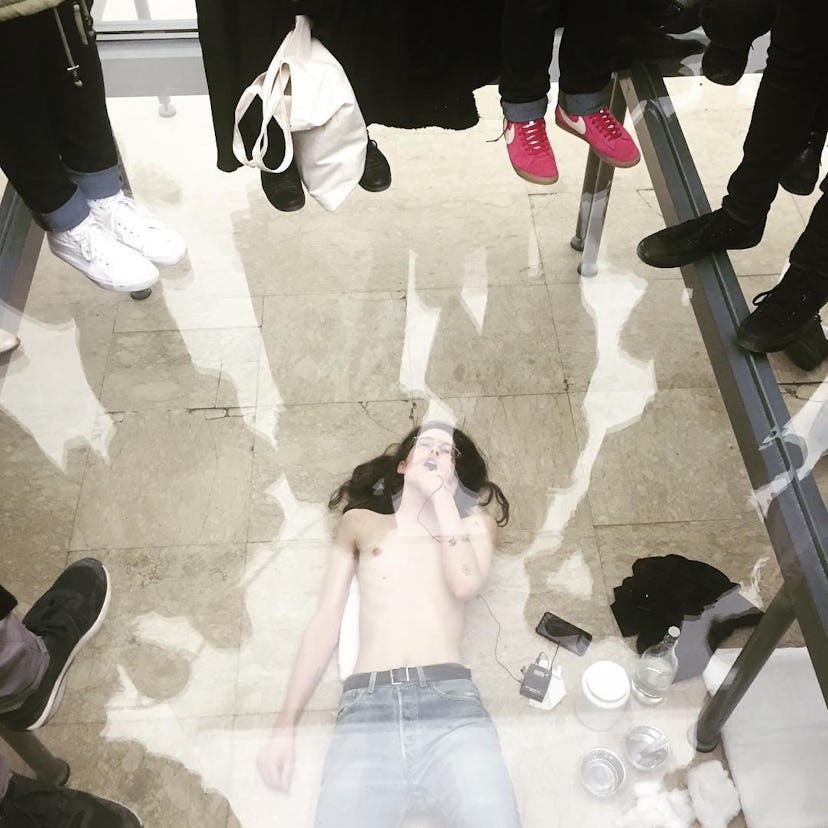The 6 Baldest Grabs for Attention at the 2017 Venice Biennale, from S&M Acts to 118-Foot-Tall Donald Trumps
At the 2017 Venice Biennale, which brings in hundreds of artists from all over the world, the key to being seen is spectacle.

With hundreds of artists representing more than 80 countries from all over the world, including Antigua and even territories like Antarctica, the Venice Biennale has also become a breeding ground for competition over the course of its 122-year history. It takes a lot of spectacle to catch the eye among so much art: Just think back to 2015, when Milla Jovovich turned up at the Barnabo garden inside a Plexiglas box, which she then treated as her dressing room. Or when, that same year, the Chinese artist Li Wei went airborne above the canals of Venice, propelling himself around via jets that produced bright green smoke over the water. The oneupmanship has not faded this time around. The 2017 biennale opened this week with a pack of caged Dobermans and a pair of 118-foot-tall trolls, and the look-at-me spectacles continued offsite as well, with concurrent exhibitions like Damien Hirst’s epic shipwreck, which might just might be the most expensive showing ever by a contemporary artist. Here, the boldest and baldest plays for biennale visitors’ attention.
Egill Sæbjörnsson at the Icelandic Pavilion
The exhibition title “Out of Controll in Venice” may appear to contain a typo, but it’s quickly that’s not all that’s a little off about Egill Sæbjörnsson’s show for Iceland’s pavilion, starting with its press release: “When Sæbjörnsson was invited to present the Icelandic Pavilion at the Biennale Arte 2017, he decided to hand that task over to Ugh and Bõögâr—or rather, he had little choice, as the trolls would have been too jealous of him creating the Icelandic Pavilion and would probably have eaten him.” Instead, in partnership with Sæbjörnsson, the trolls, who are 118 feet tall, have been projected onto the walls of the exhibition, in turn with huge likenesses of Margaret Thatcher and Donald Trump. With seats, tables, and even a coffee shop inside, you’re free to hang with the crew, too, though you may not exactly want to—word on the street is that in addition to yelling about humans and particularly curators, they’re also, um, a bit gassy.
Anne Imhof at the German Pavilion
Undeniably the buzziest, Anne Imhof’s installation for Germany, “Faust,” is also one of the biennale’s loudest: A pack of Dobermans bark at approaching visitors from behind wire caging at the entrance. There are more dogs roaming about inside, too—as well as a glass platform where performers, some of them topless, writhe about atop chains, mysterious liquids, and a leather mattress. Other assorted items around the pavilion, which apparently reeks of sanitary disinfectant, include an electric guitar, a hose, an industrial sink. Meanwhile, performers like Imhof’s partner, the artist and Balenciaga model Eliza Douglas, prance around the crowds of visitors—many of whom have waited hours for entry—looking at their phones, singing, dragging their feet like zombies, and reportedly even masturbating. Less than a week in, it’s all made Imhof one of the top frontrunners for the Golden Lion for National Participation prize, and already landed her the 2017 Absolut Art Award—prize money she’s planning to use to stage a performance in a salt desert.
The Play at “Viva Arte Viva”
In a recreation of a 1972 performance in which a Japanese art collective lived on a floating house they sailed for five days, the Kansai-based art collective The Play, which has existed in various forms since 1967, has moved into the biennale’s main “Viva Arte Viva” exhibition with a floating home of their own, which can be found both on land and at sea for hours over the course of the biennale’s run.
Erwin Wurm at the Austrian Pavilion
The Austrian artist Erwin Wurm has made it possible for visitors to turn their butts into art by hanging them out of the holes in what looks like a trailer overhauled to host a series of “one-minute sculptures,” which visitors create themselves by popping their legs through the ceiling, taking a seat atop a nearby suitcase, or by leaning their head against a propped-up chair. Including the crowd—always a crowd-pleaser.
Damien Hirst, “Treasures from the Wreck of the Unbelievable”
Damien Hirst, Hydra and Kali Discovered by Four Divers.
Though not technically a part of the biennale, Damien Hirst’s epic exhibition “Treasures from the Wreck of the Unbelievable” at the collector François Pinault’s two art spaces opened up in the city just a few weeks before the biennale, just in time for the international art world to come gawking. Hirst’s latest, which was a full decade in the making, is reportedly the single most expensive art show ever put on by a contemporary artist. Even his premise sounds rich: All of the 189 works in the show, including a bronze sculpture that towers five stories high, are supposedly remnants of the art collection of a former Turkish slave named Cif Amotan II, which has been lost at sea since the first or second century—until Hirst dug it up and brought it to Venice, that is.
Edith Dekyndt at “Viva Arte Viva”
At the end of the biennale’s “Viva Arte Viva” exhibition is a work that likely didn’t need too many art handlers to install. The Belgian artist Edith Dekyndt’s One Thousand and One Nights is basically a giant pile of dust, which she’s enlisted a man to sweep repeatedly until it is perfectly framed by a square of rectangular light.
Meet India Salvor Menuez’s Version of Botticelli’s The Birth of Venus, Who’s Still Naked, but Much Snarkier: